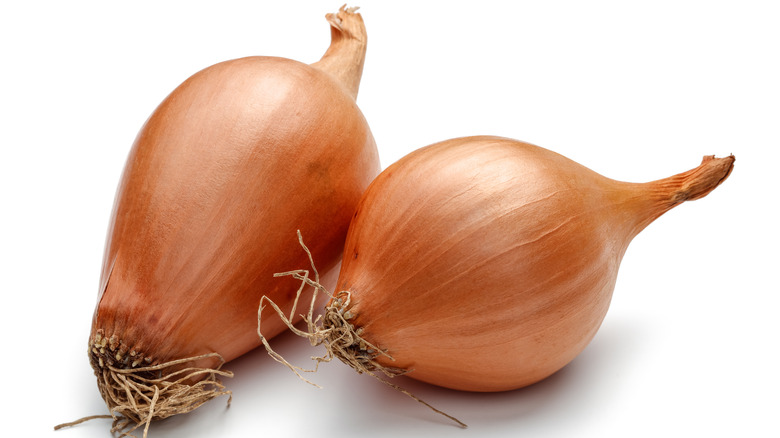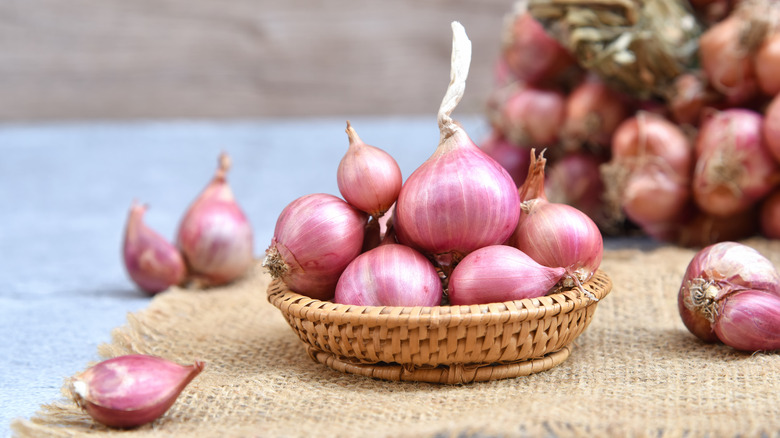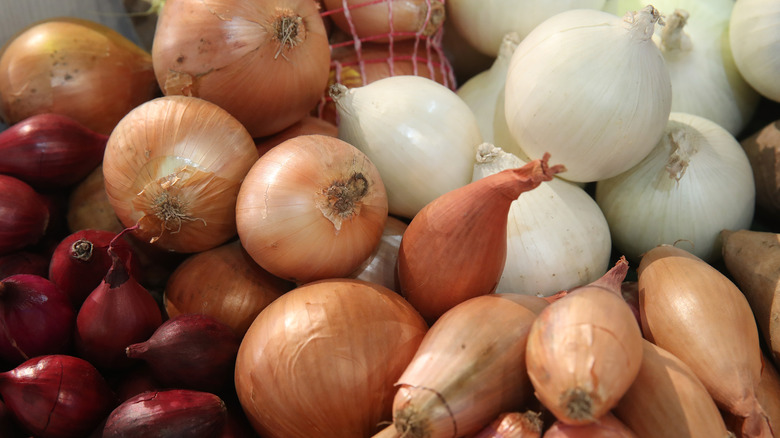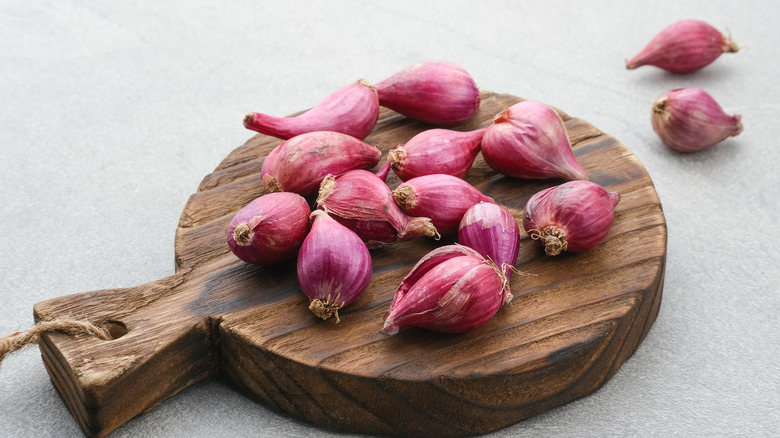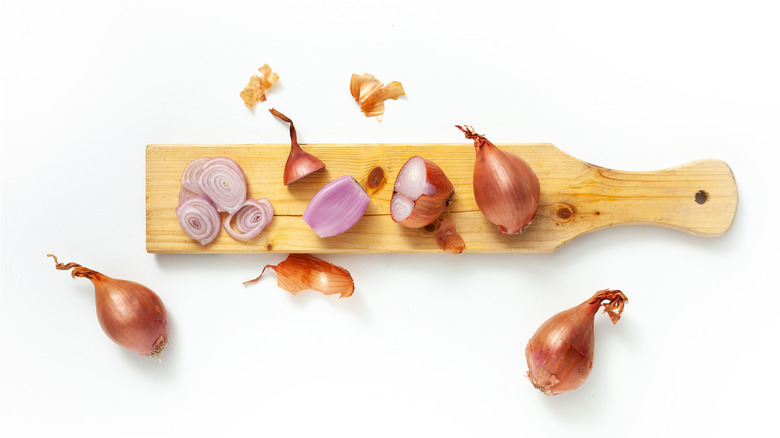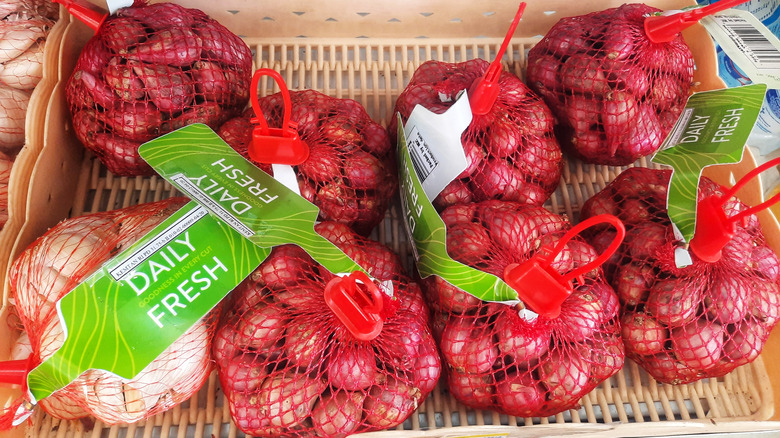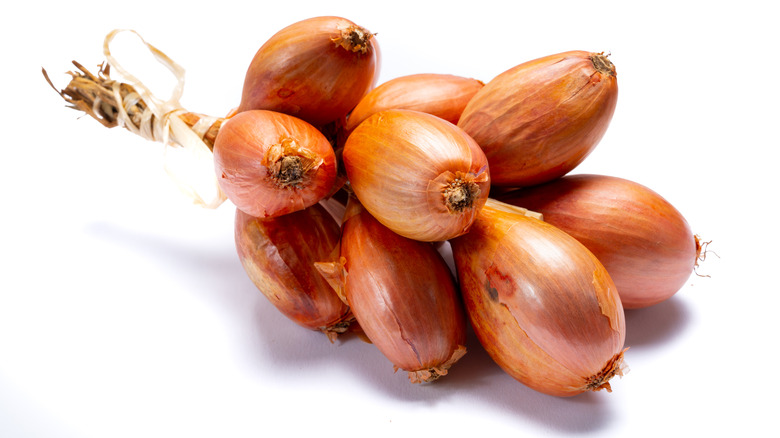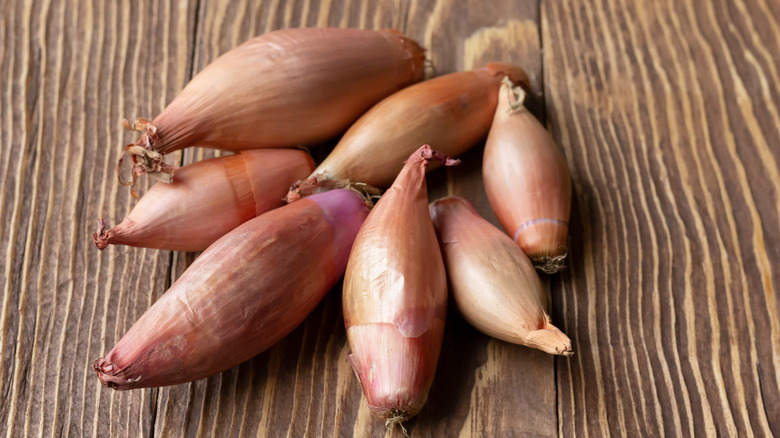What Are Shallots And What Do They Taste Like?
Alliums are often underappreciated. They are rarely the star of a dish, but they do plenty to improve the flavor of food. According to Wide Open Eats, the genus known as alliums consists of flowering plants including onions, shallots, garlic, leek, and scallions. Though they belong to the same family tree, every type of allium has a different appearance and use, making it worthwhile to seek out the best one for each recipe.
While shallots (Allium cepa) are often lumped together with the more common onions and garlic, the bulbs were previously categorized as part of a distinct family (via The Spruce). Although they are now classified alongside onions, shallots have properties that make them uniquely versatile in a wide range of dishes. If you've never had the chance to enjoy the sweet caramelized flavors of a slow-roasted shallot, then you are in for a treat. Shallots are ideal ingredient to add depth and complexity without overpowering the other flavors of a dish.
What are shallots?
According to MasterClass, shallots have been around for a while. They were first used medicinally in Ancient Egypt, and later by the Ancient Greeks who came across the allium at the port of Ashkelon in current-day Israel. The Spruce Eats explains that they were brought to Europe by the crusaders in the 11th century and soon found a steady place in French cooking. Other accounts suggest they are native to Central Asia and were even used by the Romans (via FoodPrint).
To this day, shallots are associated with French cuisine and are staples in certain foundational sauces like Béarnaise and Bordelaise. Consequently, many shallots are grown in France and surrounding countries in Europe, though Libertyprim notes that the majority are actually produced in Indonesia and exported.
Shallots look like oblong tear-shaped onions, although they are a fair bit smaller than the average onion. However, there are different varieties that can range in size as well as color. The Spruce Eats remarks that some shallots have a pinkish-copper papery outer shell while others border on gray. The interior is generally deeper purple and contains a few cloves, much like garlic. Similarly, both garlic and shallots grow in clusters underground.
Shallots vs. Onions
MasterClass explains that a fundamental difference between the two alliums lies on a cellular level. Shallots melt with greater ease, making them an excellent foundation for rich sauces and stock. The two behave distinctly when cooking, however, their differences are also evident from the outside. Shallots are smaller and teardrop-shaped with thinner skin, whereas onions tend to be larger and round. Shallots also tend to contain multiple bulbs with circular rings, whereas an onion does not. As far as the flavor goes, shallots can be milder than onions when they are raw and they have a greater potential for caramelization when cooked.
If you find yourself with a recipe requiring onions and you only have shallots, Wide Open Eats recommends using three for every onion due to the size, noting that the flavors will be subtler and sweeter. On the other hand, replacing shallots with onions will result in a more pungent bite, so yellow onion would be the best substitution, according to MyRecipes. The outlet also mentions that it's best not to replace raw shallots with raw onions, as the flavor will be too overpowering.
What do shallots taste like?
Not only do shallots look like a cross between a garlic and an onion bulb, but Wide Open Eats also describes that they taste like a milder onion with a hint of garlic. You will definitely notice a sweeter touch since proportionately, shallots contain more sugar than onions (via This One vs That One). However, the flavor of a shallot varies significantly depending on whether you consume it raw, slow-roasted, fried, or pickled.
When they are fresh and eaten raw, they are crunchy with a flavor reminiscent of red onion. As you begin to cook the allium, its structure breaks down and develops a sweet, caramelized flavor that melts in your mouth. Other preparations will further affect the flavor and texture. Fried shallots taste much like any fried item, providing a satisfying crunch and a sweet and salty taste. Pickled shallots vary depending on the brining solution, however the pungent onion flavor usually has the time to mellow out, making for a pleasantly crispy bite.
How to cook with shallots
Start by cutting off the root end, then remove the papery shell encasing. You will probably find a couple of cloves inside. Depending on your recipe, keep the cloves whole and slice them into rings or dice them — be advised that you might start to tear up. For ease, slice the shallot lengthwise, then place the flat side down and dice it into smaller pieces. Although shallots are not usually the main part of a dish, they are an integral part of many recipes. You will definitely want to include them in stock, sauces, stews, quiche, or pot roasts to add flavor.
Food Print asserts that shallots are a staple in French cuisine, acting as a foundation for a number of sauces and preparations. They regularly appear in Southeast Asian dishes as pastes, sauces, and crispy garnishes. If you're looking for a light crunch, fried shallots are delicious as a topping. Since the flavor is subtle, raw shallots are commonly used in dressings and dishes for an added kick. They are a key ingredient in mignonette, a vinaigrette for oysters made with shallots, red wine vinegar, and ground black pepper (via Bon Appétit). Pickled shallots also make a great crunchy topping for salads, sandwiches, and tacos.
The Spruce Eats suggests slowly roasting or sautéeing them in butter, which helps release sugars, leading to a more pronounced sweetness and a texture that melts in your mouth.
Where to buy shallots
Shallots are typically be found alongside onions and garlic in the produce aisle of most supermarkets. They may be sold loose but are also commonly packaged in multiples in bags made from netting. When choosing the optimal shallot to bring home, avoid any that are not firm, as they are past their prime. Bon Appétit adds to steer clear of shallots that have already sprouted. While they won't harm you, The Spruce Eats explains that the flavor will be far more bitter. To ensure that the shallot hasn't dried out inside, opt for ones that feel nice and weighty for their size with smooth taut skin that hasn't begun to wrinkle (via ABC Everyday).
Gardener's World indicates that the allium can be grown from fall to spring, and since it can be stored long-term, you are likely to find fresh shallots throughout the year. Keep an eye out for recent harvests at local farmers' markets in the summer. Once you bring them home, store them somewhere dry, cool, and dark to prevent any sprouting or molding. Kept well, ABC Everyday remarks that they will stay fresh for months.
Nutritional information about shallots
Although you probably won't be eating platefuls of shallots, it is relevant to know that this foundational ingredient has excellent health properties. In fact, Healthline reports that shallots have a long history in traditional medicine as a remedy for colds and flus, and their cooling characteristics make them a useful remedy to decrease inflammation.
Modern-day nutrition science has also found plenty of impressive qualities in the small alliums. According to a study published in the Journal of Agricultural and Food Chemistry in 2004, shallots had the highest level of antioxidants among 11 alliums. Aside from fighting cell damage and cancer-causing agents, Healthline notes that one of the antioxidants "may act as a natural antihistamine."
The New York Times explains that alliums contain sulfur compounds which are responsible for their pungent smell, flavor, and ability to make you cry. While they act as a defense for the plant against predators, they have beneficial effects in humans, thanks to antibacterial, antiviral, and antifungal properties (via Healthline). In turn, healthy heart functioning, cholesterol levels, and blood sugar regulation are all supported. Shallots are also dense in a number of micronutrients including potassium, magnesium, iron, folate, calcium, zinc, and vitamins B, A, and C. Additionally, they provide decent amounts of fiber and protein by weight.
Other varieties of shallots
The French, gray, or golden shallot is considered by many to be the standard classic in cuisine, according to MasterClass. The Jersey shallot, another common variety, is a reddish-purple color — ABC Everyday remarks that it is often used in Asian cuisine. Meanwhile, banana shallots which MasterClass indicates also go by the name echalion, are actually a hybrid of a shallot and onion. They are slightly larger than the average shallot and tend to be long and thin.
While you won't find all of the shallot varieties in most grocery stores, gardeners or farmers market frequenters might be familiar with Frog's Leg shallots. As The Spruce describes, it's an heirloom type that gets its name from its appearance, which recalls an amphibian's legs. The source lists other varieties including Ambition and Conservator, which are both hybrids.
The shallot types don't stop there: The Spruce Eats indicates that supermarkets might carry Prisma shallots, which have a shinier external shell. In fact, there are dozens of varieties of shallots of varying sizes, ranging in color from grayish gold to pink and purple. The flavor differences are generally not significant, although some might be slightly milder or sweeter.
